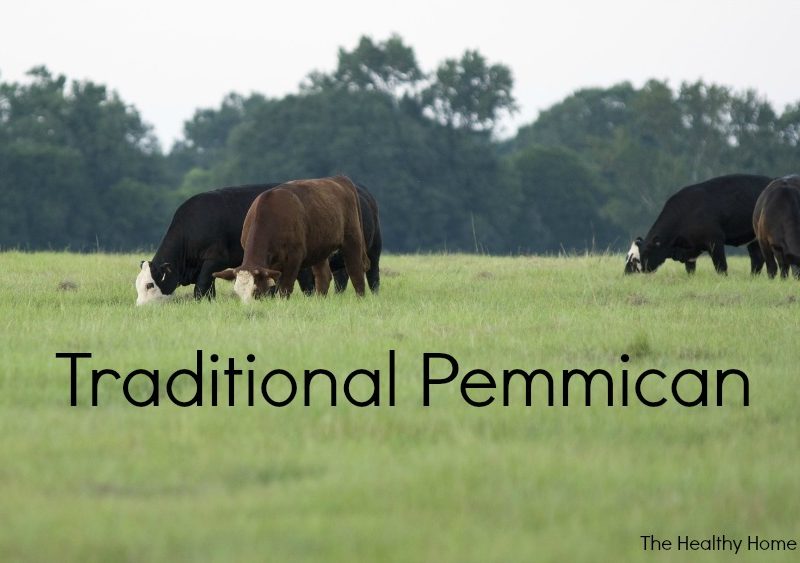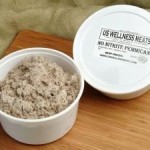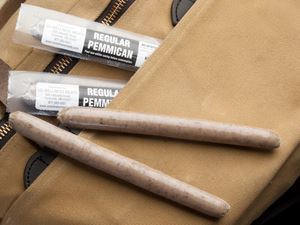
Imagine it is five hundred years ago and you find yourself traveling across the northern plains during the winter. Temperatures are well below freezing. The wind is strong. Water is scarce, food even scarcer. What would you eat? Where would you find it? Would it be nourishing enough to sustain you? Native Americans understood and had an answer to this problem, and the answer was pemmican.
What is Pemmican?
Pemmican is the ultimate survival food. As it turns out, it is delicious and healthful for modern-day eating as well.
Thoroughly dried lean meat forms the basis for this traditional food, which is then ground into a powder or chopped into small, fine pieces. It appears the meat used in pemmican was originally not powdered, but instead pounded down to fibers. This seems to result in a more shelf-stable and digestible product. However, for practical reasons, the powder does just fine for average long term storage (a few years or more depending on the amount of salt and storage conditions).
Beef or bison are the favorite types of meat for modern versions. However, Native Americans made traditional pemmican from a range of lean cuts of bison, elk, moose, and deer and perhaps on occasion, even bear.
The meat is then mixed with traditionally rendered tallow. The addition of a nourishing fat was considered so essential, that the name pemmican is actually derived from the Cree word pimi, which means fat or grease.
Once blended in the appropriate protein/fat ratio, pemmican looks a bit like duck or chicken pate. It can be consumed in this form or shaped into cubes or sausage-like strips for grab and go convenience.
Pemmican vs Jerky
Pemmican is often confused with jerky, but they are actually quite different foods both texturally and nutritionally speaking.
Jerky is made with just the lean muscle meat, dried in thin chunks. Sometimes jerky is tenderized before drying.
Before the drying process, it is usually marinated in a mixture of herbs and spices to impart flavor. Drying is achieved either by sun, smoke or mechanical dehydration. If the marinade does not include any sugar, jerky ends up being pure protein as a final product.
Pemmican, however, contains fat too which is what allows this unique provision to be considered a complete food. One cannot live on jerky alone, but a person can subsist for weeks without any loss of health on pemmican! More on this below.
How Nourishing is Traditional Pemmican?
Anthropologist and explorer Vihljamur Stefansson observed that the Inuit would spend weeks away from camp with nothing more than pemmican to eat and snow to drink. Despite this extremely limited diet, they would return in sterling condition.
While living with the native peoples, Stefansson himself adopted a pemmican habit enjoying the same health-preserving results. European settlers quickly embraced the practice as well, trading with the Native Americans to obtain this valuable, lightweight, and nutrient-dense food while learning to make it themselves.
Historical Importance
So important was pemmican for survival that at one point it was the cause for war. In 1814, governor Miles Macdonell started the Pemmican War with the Métis when he passed the short-lived Pemmican Proclamation. This edict forbade the export of pemmican from the Red River Colony.
Without pemmican, many early feats of exploration would have been impossible until much later. Robert Peary had this to say about his famous expeditions to the North Pole, where pemmican played a crucial role in the nourishment of both man and dog:
Too much cannot be said of the importance of pemmican to a polar expedition. It is an absolute sine qua non. Without it a sledge-party cannot compact its supplies within a limit of weight to make a serious polar journey successful.
A Pemmican Variety for Every Occasion!
Variants of pemmican abound, with the Native Americans even reserving special ceremonial and wedding recipes for this traditional food.
Sometimes, in addition to the meat and fat, enthusiasts add in other foods as well. Common choices include dried and crushed berries, nuts and even honey.
Modern folk have an almost limitless array of items to add to their pemmican. Native Americans could have only dreamed of such a variety! If you plan to consume your pemmican sooner rather than later, such additions are not a problem. If your primary purpose for making pemmican is long term, storage, however, the more additional items you add, the less shelf-stable your final product may be.
Taste and Texture
Properly made pemmican made with just meat and fat if stored properly lasts many years, even decades. Native Americans made special leather sacks packed with pemmican and sometimes stored these in special places along commonly traveled routes. So, if you are looking for affordable nutrient-dense storage foods, pemmican may be the solution you are looking for!
While pemmican often comes in the shape and size of a standard store-bought snack bar (like a CLIFF or Lara bar), it has a very different taste and texture. Ultimately, the type of meat and fat used strongly determines both of these characteristics.
For me, I liken pemmican to the Elven Lembas Bread from the Lord of the Rings trilogy. The more you eat pemmican, the better it tastes and the more nourishing it becomes.
Steps for Making Traditional Pemmican
The best and most nutritious pemmican starts with a lean cut of grassfed or wild animal, such as a shoulder roast.
Since the meat will be dehydrated, you will need to start with 4-5 pounds of lean meat to finish with about 1 pound of pemmican. To get some idea of how dense pemmican is, a taureau or bag weighing about 90 lb/41 kg required an entire buffalo! Keep in mind that the average buffalo weighs 1400 lbs/635 kg!

Traditional Pemmican Recipe
Traditional recipe for making pemmican, humankind's first Power Bar courtesy of the Native Americans who perfected the method many centuries ago.
Ingredients
- 4-5 pounds raw grassfed meat fresh or frozen
- 4 cups grassfed tallow
- berries, seeds and/or nuts optional
- sea salt optional
- coconut flour optional
- almond meal optional
- raw honey optional
Instructions
-
Meat is easier to slice thin when slightly frozen. So, if the meat you are using is fresh, toss it in it the freezer for a few hours. If it is frozen, partially thaw it out. Once the meat is partially frozen, use a knife to carefully cut it into long, thin slices.
-
Trim off any visible fat from the strips.
-
Place the slices either in a dehydrator or an oven that can be set very low (150 °F/ 66 °C). It takes about 12-18 hours to thoroughly dry the meat strips.
-
Use a food processor or a mortar and pestle to powderize the dried meat.
-
If you are adding berries, nuts or other extras, add them now. Use about half as much as you have meat. For example, if you have 4 cups of dried meat, add 2 cups of extras.
-
Traditional pemmican did not use any salt, but if you wish to add some, about 1/2 teaspoon of sea salt per cup of meat is a good rule of thumb.
-
Next, you will add the fat. The proper ratio of meat to fat is 1:1 for traditional pemmican. This means if you end up with 4 cups of dried meat powder, you will need 4 cups of rendered fat. The ratio of fat to meat matters, especially if this will be the only food someone is subsisting on for any length of time. Explorers discovered that other ratios were not as nourishing or healthful.
You can either buy grassfed rendered tallow or make tallow yourself. Generally, the suet fat located around the internal organs like the kidneys was used and preferred by the Native Americans because it is the most nutrient dense fat.
-
Warm up the fat on the stove until it liquefies. Mix the fat slowly with the meat, allowing the dry mixture to soak it up before adding more. Work the mixture with your hands much like you would bread dough if you like.
-
If you have any wet extras such as raw honey, add them after the fat. Some people use almond meal or coconut flour if the mixture becomes too wet or moist.
Recipe Notes
Use no more than 2 cups total of optional ingredients.
Remember, the more extras (nuts, seeds, or berries) you add, the less shelf stable the pemmican becomes. It also becomes less pemmican and more snack bar. Modern types of pemmican with additional ingredients beyond just the meat and fat are best kept in the freezer for this reason. If you wish your pemmican to be shelf stable and last for years, go with meat and fat only.
Storage
Once finished, the mixture can be made into bars, slabs or balls for storage. It is good to label your storage bag or container with the date the pemmican was made, and some people will also record each batch’s ingredients for future reference and improvements. The picture below shows pemmican in small, cigar-shaped bars.
 It is best to store pemmican in a cool, dark, and most importantly DRY place, inside an airtight container or a container that will not attract moisture.
It is best to store pemmican in a cool, dark, and most importantly DRY place, inside an airtight container or a container that will not attract moisture.
If you have the ability to vacuum pack it, even better!
Buying Authentic Pemmican
More people wish to enjoy pemmican than actually wish to make it. If this is you, fortunately, there are a number of companies and farms that now offer it.
My recommendation for a trusted pemmican source if you wish to ship it to your door is US Wellness Meats.
If you choose another pemmican manufacturer, be very careful. Many businesses are cashing in on catchy food buzzwords and selling food called pemmican that is anything but traditional!
Check out this scammy “Pemmican” protein bar from Bear Valley.
Ingredients: Malted Corn and Barley, Nonfat Milk, Honey, Wheat Germ, Raisins, Soy Flour, Walnuts, Soy Oil, Wheat Bran, Pecans, Grape Juice.
Notice anything missing from this pemmican bar? Yep, you got it! There is no meat and no nutrient-dense animal fat. How do companies get away with this?
The bottom line…if you choose to buy instead of make pemmican, be very sure about your supplier!








Please edit this article to include the word “dried” berries as an option! That word is missing. All products must be throughly dry. The meat strips should break—not bend.
Since pemmican doesn’t need to be frozen, they’ll waive the weight limit for pemmican if you call them and ask.
I want to order some legit pemmican from us wellness but they have a 7lb minimum. Doing that with just bars is wayyy to pricey. So I’m looking to just a few of their 2lb pails. But are there any kinds of recipes I can use this in or are you supposed to just eat it straight from the pail with a spoon?
You can use the pemmican from the pail to make your own bars.
Please, it must be pointed out that the only reason “lean meats” were used is that all *wild* grazing mammals are lean. Farmed deer, elk and buffalo will have much more fat on them. The fat for pemmican had to be sourced from porcupine, beaver or muskrat (or occasionally, depending on the tribe, bear). And no, First Nations people would not have used “sweeteners like honey” – there are no honey bees native to this continent, nor are there sugar maples on the prairies or in the far north. The pemmican was not stored in “leather” which is cow hide, but moose or deer hide. The methods of tanning these hides make them different from leather in ways that are subtle but important to the preservation of the pemmican.
I may seem to be splitting hairs here, but it educates no one to read articles with vague “factoids” about the cultural heritage of the First Nations peoples.
As for ordering factory produced “pemmican” from the internet and calling it “authentic” – that would be funny if it wasn’t so sad. More like “Cultural Appropriation”!
As the elderly often have difficulty producing enough saliva, Pemmican was very often turned into a soup for the elders. You could try that.
We love pemmican from US Wellness. My son can no longer eat beef, so we haven’t bought any. Your post has inspired me to make my own using pork, lard and salt. Thanks!
Great article. Can you thaw out frozen venison and use the meat for the pemmican?
Yes absolutely!
Mind blown. Would this be soft enough for someone with no teeth? Is it sticky? Mom needs more nourishment than potatoes as she adjust to dentures… and this seems like an amazing find. I’d have to dress it with honey etc but wow.
Pemmican is quite soft, yes, due to the powderizing of the meat and the soft fat mixed into it. Would be an incredible, nourishing food for an elderly person.
Thanks for this info. It’s the first recipe I’ve come across for making pemmican that sounds doable and maybe tasty (I confess I like a really dry jerky and do not like – at all – those jerky sausage sticks). I do have a question, though, on the ratio of meat to fat. Is it still a 1:1 ratio of meat and fat even if fruits or nuts are added, or is it a 1:1 ratio of meat+extras to fat?
The meat and fat would stay 1:1 even if other ingredients are added. Add other ingredients at a suggested 1/2 amount by volume to the meat. So if there are 4 cups meat, 4 cups tallow, you can add up to 2 cups other ingredients.
Look up how to make Biltong. By the way the “native Americans” were the Solutrean.